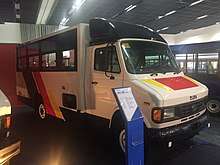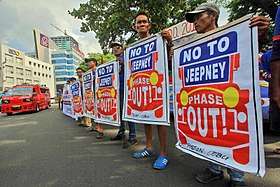Public Utility Vehicle Modernization Program
The Public Utility Vehicle Modernization Program (PUVMP) was launched by the Department of Transportation of the Philippines in 2017, with the goal of making the country's public transportation system efficient and environmentally friendly by 2020. The program calls for the phasing-out jeepneys, buses and other Public Utility Vehicles (PUVs) that are at least 15 years old and replacing them with safer, more comfortable and more environmentally-friendly alternatives over the next three years. Currently, there are 220,000 jeepney units operating throughout the country.[2]
.svg.png) | |
| Date | 2017-2020 (Projected) |
|---|---|
| Type | Transportation program |
| Cause | Safety and environmental concerns |
| Target | Phase-out and replacement of all PUVs 15 years or older |
| Budget | ₱2.2 billion[1] |
| Organized by |
|
Replacement vehicles are required to have at least a Euro 4-compliant engine or an electric engine to lessen pollution. Some proposed requirements include CCTV cameras, Panta Transportation Payment Terminal, speed limiters and GPS monitors.[3]
The Land Bank of the Philippines estimates that each jeepney replacement will cost around ₱1.4 million to ₱1.6 million.[4] However, based on an interest rate of 6% per annum and a payment period of 7 years, the actual cost of a jeepney reaches ₱2.1 million.[5]
Some transport groups have criticized the program as "anti-poor". These groups have pointed out that under the program, most drivers and small-time operators would be unable to afford replacement units and corporate entities would seek to monopolize the market and impose fare hikes on commuters.[6][7]
Goals
In addition to the phase-out of old jeepneys, the program aims to change the current franchising system, revise and introduce new routes and provide training to jeepney drivers.
The program, according to the DOTr, has the following goals:
- Safe and comfortable transport
- Predictable travel time
- Disciplined and competent drivers
- Fair regulations
- Spacious jeepneys
Furthermore, the Department claims that the program's environmental and economic benefits will be felt by commuters, operators and drivers alike: The changes in routes and optimized networks will be more convenient for commuters. Drivers will have better monthly salaries and benefits and their health will be better of because of the reduced traffic congestion and pollution. Finally, operators will be able to accept more passengers with the reduced traffic and can reduce costs under the franchising scheme by sharing services.[8]
Implementation



In June 2017, Transportation Secretary Arthur Tugade signed the Omnibus Franchising Guidelines (OFG), which reformed the process of granting jeepney franchises by introducing new rules on route planning and setting new standards for vehicles and drivers.[9]
Under the OFG, Local Government Units are required to come up with their own Local Public Transport Route Plans.
These plans will be based on existing and projected travel patterns and will be considered by the Land Transportation Franchising and Regulatory Board in issuing new franchises. Single-unit operators will no longer be granted franchises.[10]
Crackdown on dilapidated vehicles
In January 2018, Metro Manila's Inter-Agency Council on Traffic (i-ACT) launched operation 'Tanggal Bulok, Tanggal Usok', targeting vehicles for environmental and safety violations such as smoke belching, worn out tires and lack of seat belts. As of January 23, a total of 1087 vehicles, mostly Public Utility Jeepneys (PUJs), were flagged down, apprehended and issued summons. To accommodate affected passengers, the Armed Forces of the Philippines have been offering free rides.[11]
Prototypes
In October 2017, the Land Transportation Franchising and Regulatory Board (LTFRB) and the Department of Trade and Industry (DTI) presented sixteen prototype jeepneys. These models were all locally manufactured and based on guidelines set by the DOTr. Features include:
- Euro 4 engines
- CCTV Cameras
- GPS
- Automated fare collection systems
- Front-facing seats
- New exits on the right-hand side[12]
Financing
An estimated ₱1.5 billion will be given to transport corporations and cooperatives to purchase new PUVs through the Development Bank of the Philippines' Program assistance to Support Alternative Driving Approaches (PASADA). The program will feature a 5-percent equity for vehicle purchase, 6-percent interest rate and seven-year repayment period.[13][14]
Under PASADA, a maximum of 95 percent of the cost of the vehicle, and a maximum of 75 percent of the cost of the support facilities comprise the total loan per borrower. The government will also offer a maximum subsidy of ₱80,000 to cover the equity payment.[15][16]
A Memorandum of Understanding (MOU) with the Landbank of the Philippines was also signed by the DOTr to set up a PhP1 billion financing for PUJs via the Special Environment-Friendly and Efficiently Driven (SPEED) Jeepney Program.[17]
Phases
According to the DOTr, the proposed implementation time frame is as follows:[18]
- Q4 2017 Pilot program in Metro Manila
- 2018–2019 Metro Manila, Metro Cebu, Metro Davao
- 2019–2020 Highly Urbanized Cities, Rest of the Country
Support
At least twenty government agencies and twenty-four transport groups from across the country supported the launch of the program.[19] Among transport groups that supported the initiative are the Panta Transportation Network, Federation of Jeepney Operators and Drivers Association (FEJODAP), 1-United Transport Koalisyon (1-UTAK), Alliance of Transport Operators and Drivers Association of the Philippines (ALTODAP), and Coalition of Operators, Drivers, Employees, Atbp. (CODE-X), and the Philippine Confederation of Drivers and Operators – Alliance of Concerned Transport Organizations (PCDO-ACTO). [20][21][22] Pangkalahatang Sanggunian Manila & Suburbs Drivers Association (PASANG-MASDA) also expressed support. Their president Obet Martin stated, "it was high time for the country to replace the current jeepneys to more modern and more efficient units".[23]
Criticism

Even before its launch, the program was received negatively by various transport groups. While Senate Bill 1284 and House Bill 4334, the program's enabling legislation, were still pending in February 2017, jeepney drivers launched numerous strikes and demonstrations in Metro Manila and in key cities throughout the country.[24]
According to Kilusang Mayo Uno (KMU) and Pinagkaisang Samahan ng Tsuper and Opereytor Nationwide (PISTON), the ₱1.4 million to ₱1.6 million cost of new jeepneys will adversely affect the livelihood of 600,000 public utility jeepney (PUJ) drivers and 300,000 small operators. The group claims that commuters will also be hit with an increased fare of at least ₱20.[25]
According to the Crispin B. Beltran Resource Center (CBBRC), operators, drivers and commuters stand to lose from the program. By the CBBRC's estimates, the minimum requirement of 20 jeepneys per franchise will require an investment of at least ₱30 million, effectively barring small-time and independent jeepney operators. It is also claimed that the government's promises of lighter traffic are "bogus", since jeepneys comprise around only 2 percent of vehicular traffic in the NCR. Foreign and local companies will allegedly take advantage of the situation by monopolizing technology and increasing fares by up to 50 percent.[26]
On September 24, transport group Stop and Go Coalition held a transportation strike to protest the program. LTFRB board member and spokesperson Aileen Lizada said the only areas affected were Commonwealth, Litex, SM Fairview and Sandiganbayan in Quezon City. [27]
On October 16, PISTON held a two-day transportation strike. In response, the Malacanang announced the suspension of classes at all levels and of government work on October 16.[28] In a press statement, Alliance of Concerned Transport Organizations President Efren de Luna stated that their group did not join the transport strike as they found that PUV modernization wants to ensure the security of passengers and to have an environmentally sustainable mode of transportation.[29]
Senator Grace Poe, chair of the Senate public services committee, has expressed doubt over the governments readiness to implement the program nationwide. According to Poe, the government will have to shell out ₱415 billion for full implementation of the scheme, far more than the ₱2.26 billion it approved. She has suggested that the PUV Modernization Program be implemented in select cities instead.[30]
Senator Poe and Senate Majority Leader Vicente “Tito” Sotto III have called for a "middle ground" solution, saying that old but road worthy PUVs should be allowed to operate. However, the DOTr has given no clear commitment to their suggestion.[31]
References
- "Gov't allots P2.2 billion to subsidize PUV modernization –LTFRB". GMA News Online. Retrieved February 22, 2018.
- Talabong, Rambo. "DOTr launches modernization program for jeepneys, buses". Rappler.com. Retrieved October 16, 2017.
- Francisco, Katerina. "EXPLAINER: What's the reason for the 2-day transport strike?".
- "Jeepney modernization program kicks off next month". CNN Philippines.
- "Poe: Math shows operators lose in gov't bid to modernize jeepneys".
- Gabico, Katreena. "Why some transport groups oppose jeepney phaseout". Inquirer.net.
- KG. "Transport group holds strike to oppose jeepney phaseout". GMA News. Retrieved October 17, 2017.
- "14 THINGS YOU NEED TO KNOW ABOUT PUBLIC UTILITY VEHICLES (PUV) MODERNIZATION PROGRAM". DEPARTMENT OF TRANSPORTATION – PHILIPPINES FACEBOOK PAGE. Retrieved October 16, 2017.
- Patena, Aerol (June 20, 2017). "DOTr launches PUV Modernization Program". Interaksyon. Retrieved October 16, 2017.
- Furigay, Charolette (June 20, 2017). "DOTr launches OFG for PUV Modernization". Business Mirror. Retrieved October 16, 2017.
- "'Tanggal Bulok, Tanggal Usok' ops sweep off dilapidated jeepneys".
- "Proposed designs of modernized jeepney models, unveiled to the public". UNTV. October 12, 2017. Retrieved October 16, 2017.
- "DBP to provide P1.5-B finance facility for DOTr's PUV Modernization Program". Interaksyon. September 10, 2017. Retrieved October 16, 2017.
- "DBP TO PROVIDE PHP1.5-B FINANCE FACILITY FOR DOTR'S PUV MODERNIZATION PROGRAM". Department of Transportation. Retrieved October 16, 2017.
- Iglesias, Myla. "PUV modernization gains ground". Retrieved October 16, 2017.
- Rey, Aika. "DOTr hits Piston 'propaganda' on modernization program". Rappler.com.
- "DOTR SECRETARY TUGADE SAYS PUV MODERNIZATION PROGRAM NOT ANTI-POOR". Department of Transportation. Retrieved October 16, 2017.
- "14 THINGS YOU NEED TO KNOW ABOUT PUBLIC UTILITY VEHICLES (PUV) MODERNIZATION PROGRAM". DEPARTMENT OF TRANSPORTATION – PHILIPPINES FACEBOOK PAGE. Retrieved October 16, 2017.
- "24 AGENCIES, 20 TRANSPORT GROUPS AND COOPERATIVES PUSH FOR PUV MODERNIZATION". Department of Transportation. Retrieved April 14, 2018.
- "Public and private sectors push for PUV modernization". Manila Bulletin. Retrieved June 21, 2017.
- "PUV modernization program gains support". Journal Online. Retrieved June 21, 2017.
- "Major transport groups to skip 2-day strike slated next week". Philstar.com. Retrieved October 12, 2017.
- "Despite strike, other transport groups OK with jeepney modernization". GMA News Online. Retrieved October 17, 2017.
- "Transport strike: Why pick on jeepneys to fix traffic problems?".
- "Transport groups to stage 2-day strike to protest vs jeepney 'phase-out scheme'". Inquirer.net.
- "Fast Facts: Jeepney Phase-Out; Who Loses? Who Gains?". Crispin B. Beltran Facebook Page. Retrieved October 16, 2017.
- "Why some transport groups oppose PUV modernization". Philstar.com. Retrieved September 26, 2017.
- Roxas, Pathricia Ann. "No classes at all levels, no gov't work on Monday – Malacañang". Retrieved October 16, 2017.
- "Major transport groups to skip 2-day strike slated next week". Philstar.com. Retrieved October 12, 2017.
- "Poe: Govt not ready for PUV modernization".
- "Poe, Sotto: Allow old but roadworthy jeepneys on the road | Inquirer News".
| Wikimedia Commons has media related to Jeepney Modernization Program. |
